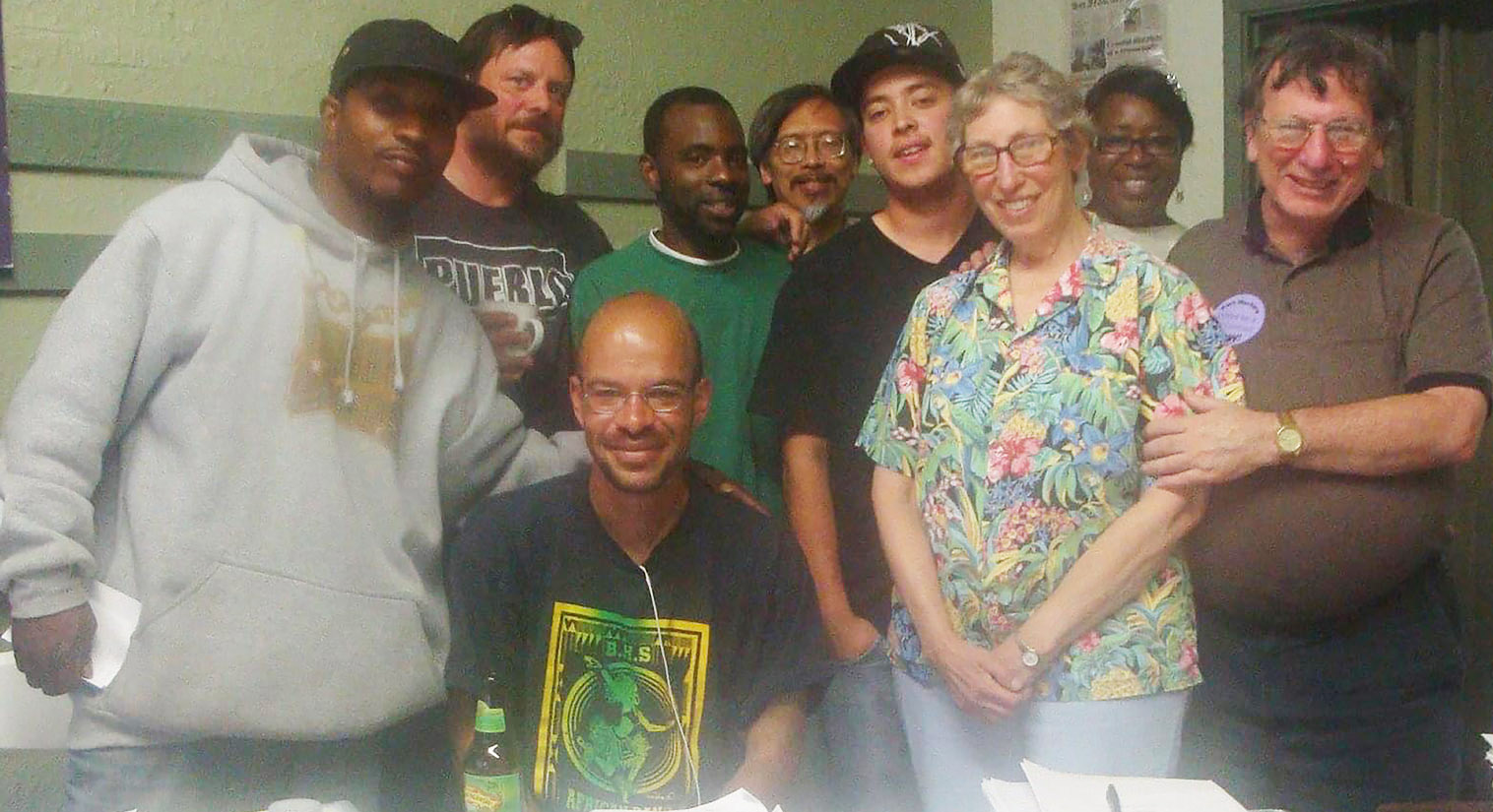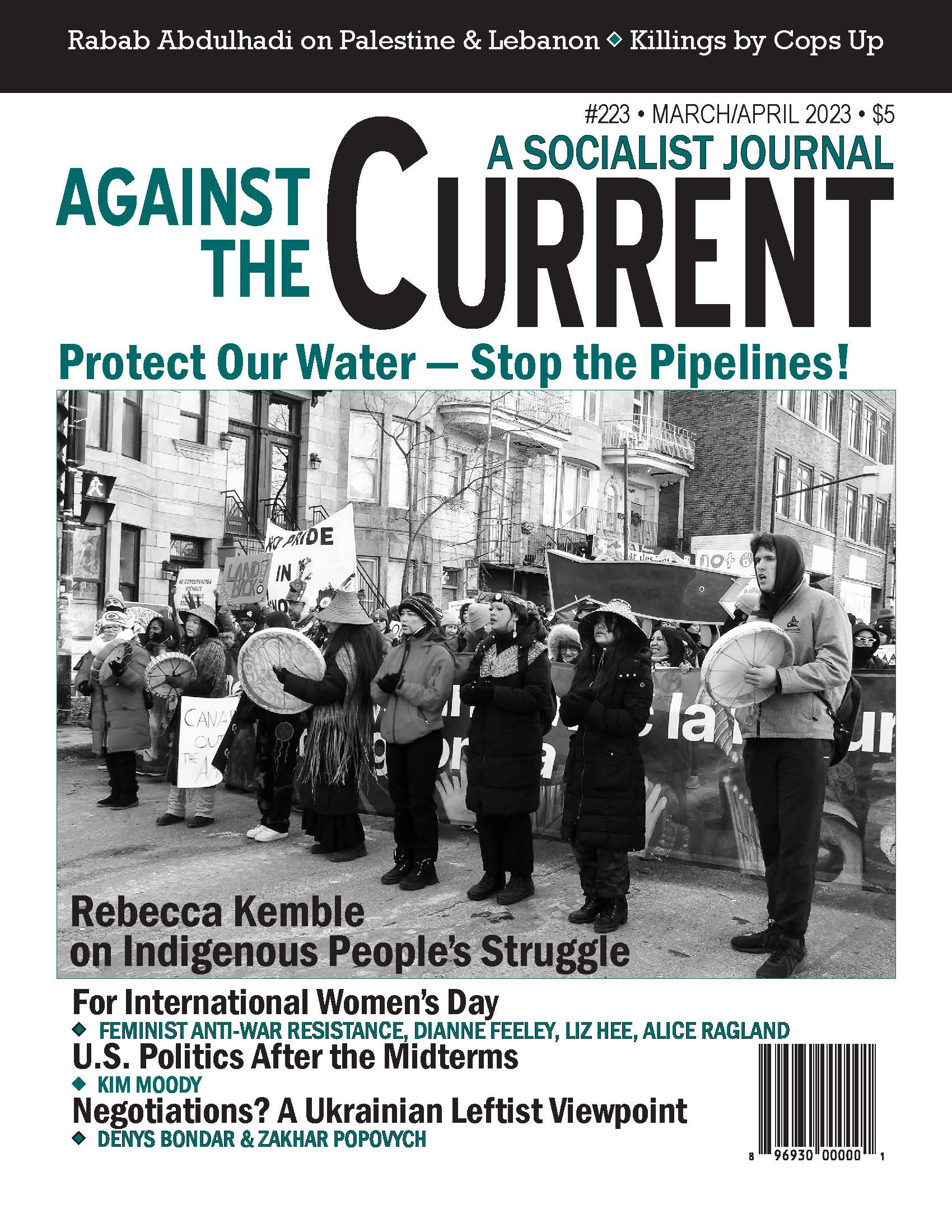Against the Current, No. 223, March/April 2023
-
Women's Rights, Human Rights
— The Editors -
Lives Yes, Pipelines No!
— Rebecca Kemble - Salvadoran Water Defenders
-
Killings by Police Rose in 2022
— Malik Miah -
View from the Ukrainian Left
— Denys Bondar and Zakhar Popovych -
Witness, Resilience, Accountability
— interview with Rabab Abdulhadi - Palestine Solidarity Activism Under Fire
- The Horror in Occupied Palestine
-
Nicaraguan Political Prisoners Freed, Deported
— Dianne Feeley and David Finkel -
Stuck in the Mud, Sinking to the Right: 2022 Midterm Elections
— Kim Moody -
Heading for the Ditch?
— David Finkel -
Paths to Rediscovering Universities
— Harvey J. Graff - International Women's Day, 2023
-
Demanding Abortion Rights in Russia
— Feminist Anti-War Resistance/ FAS (Russia) -
Before & After Roe: Scary Times, Then & Now
— Dianne Feeley -
Abolition. Feminism. Now.
— Alice Ragland -
#Adoption Is Trauma AND Violence
— Liz Hee - Reviews
-
Radical Memory and Mike Davis' Final Work
— Alexander Billet -
A Revolutionary's Story
— Folko Mueller -
James P. Cannon, Life and Legacy
— Paul Le Blanc -
The World of Professional Boxing
— John Woodford -
A Powerful Legacy of Struggle
— Jake Ehrlich -
War and an Irish Town
— Joan McKiernan - In Memoriam
-
Mike Rubin 1944-2022
— Jack Gerson
Jack Gerson

MICHAEL RUBIN DIED peacefully on December 17, 2022 at his Oakland home, at the age of 78. He is survived by his wife Jan Arnold and their son David Rubin, an assistant professor of physics and cosmology at the University of Hawaii.
For more than 50 of those years, Mike Rubin was active in the Bay Area left:
• In socialist groups: the Independent Socialist Clubs (ISC) and its successor, the International Socialists (IS), from the late 1960s to the mid-1970s; Workers’ Power (from the late 1970s to the mid-1980s); and Solidarity, since its founding in the mid-1980s.
• In labor, as a shop steward active in the SEIU reform movement, a delegate to the Alameda County central labor council, and a participant in numerous labor antiwar and strike support coalitions.
• In the electoral arena, where he was active in the Peace and Freedom Party from its founding in 1968 until about 20 years ago, when he became an active member of the Alameda County Green Party.
• In the environmental movement, where he was active in System Change Not Climate Change and was one of the founders of the Bay Area ecosocialist committee.
I’ve known Mike Rubin since 1968. For several years in the 1980s, I co-owned a two- family house near Oakland’s San Antonio Park with Mike and Jan. Perhaps that’s why I’ve been asked, here and elsewhere, to say or write some words in Mike’s memory. I want to thank the editors of Against the Current for asking me to do so.
Although Mike was neither a good public speaker nor a writer, he made a mark such that his death was noted, and mourned, by many of what’s left in this dwindling left. [A few of the articles reporting on Bay Area activism can be found under his name on the ATC website. — ed.]
Early Life and Politics
Born August 31, 1944, in Newark, New Jersey (also Jan’s hometown), Mike grew up in Phoenix, Arizona, where his family moved when he was six years old. He recalled, “In 1960 when I was in high school, during the elections one Irish kid, and me, were the only Democrats. Everyone else in my high school was for Nixon.”
In college at the University of Arizona in Tucson, where joined the Young Democrats (1963), “I had gotten involved in the Civil Rights movement. By 1965 there was a CORE (Congress of Racial Equality) chapter in Tucson and I was a nominal member.”
In Mike’s account, “I moved left in series of well-demarcated steps; I was a liberal, then a left-liberal, then a radical, then I met the Left…The first Leftists I met were the Communist Party. They tried to recruit us but they didn’t interest me, because what they were pushing was where I was leaving. The line of the Communist Party was, and still is, for that matter, that we should all be Democrats. I was leaving the Democrats.
“After college I signed up as a VISTA volunteer. (That was called ‘the domestic Peace Corps.’) I was sent to Baltimore for training.
Activist Commitments
“The Baltimore Committee to End the War in Vietnam was a sort of united front of leftists, and Hopkins SDS. While in Baltimore I met the Independent Socialist Club. I said ‘This is for me,’ and I joined in the spring of 1967.” Shortly afterward, Mike moved to the Bay Area. He and Jan began dating in 1976.
I first encountered Mike Rubin at a San Francisco Peace and Freedom Party meeting in the summer of 1968. Mike stood at the door silently, holding a copy of the ISC newspaper in front of him. Those meetings, at that time and place, were crawling with flamboyant individuals vying for recognition. Mike got little attention and few takers. He rarely spoke at the meetings. But meeting after meeting, he was always there.
In the late 1960s, many of us believed that the mass movements would, one way or another, lead to sweeping social change: vast improvements in material well-being, and giving people far more control of society and their lives. But as the movements receded in the ’70s and ’80s, as millions of activists returned to everyday life — families, careers, climbing corporate ladders.
Mike stayed the course, while most of the more prominent folks drifted away. What distinguished Mike was an enduring belief in core principles from the 1960s ISC/IS, as broadened and somewhat modified over time and in practice.
I think that those core beliefs were (I am not in full agreement with some of these — especially on electoral politics — but this isn’t about me):
• Socialism from below: The emancipation of the working class can only be accomplished by the working class, with control over society’s key institutions organized democratically from the ground up.
• Independent political action: Engaging in electoral action and mass action in the interests of the “have-nots,” counterposed to the interests of the capitalist class and its political representatives, the Democratic and Republican parties. Historically conceived as calling for a working class “labor party,” it was adapted by Hal Draper and others in 1967-68 to advocate for the more cross-class Peace and Freedom Party, and eventually by many (including Mike) to embrace the Green Party. Adapted or not, Mike remained fiercely opposed to working in or supporting candidates of the Democratic Party.
• The “rank and file” approach to labor organizing — organizing “rank and file reform caucuses” fighting against the bosses, bureaucratic “business unionism,” and for better wages and working conditions.
Over time, the framework was modified as certain points such as anti-racism were made concrete:
• Support for emerging liberatory movements (which took clearer shape, pushed by emerging forces — e.g. the 1968 Peace and Freedom Party/Black Panther Party alliance; support for women’s liberation)
• “Socialist regroupment”/united front/building coalitions — I think that the key influence on Mike’s views here was the American socialist and teacher unionist Steve Zeluck.
• Ecosocialism/“System Change Not Climate Change”> — the essential need for environmental action now, with the conviction that only a revolutionary reorganization of society could solve the existential crisis posed by global warming / climate change.
Mike’s was steadfast, I think, because he really believed in all of the above — and had the courage of his convictions and would always stand up for what he believed.
That’s why he’d make nearly every meeting and every demo of consequence. It’s why this guy, who couldn’t be coaxed into taking a walk for exercise under any circumstances, would show up in howling storms to march through the streets of Oakland or San Francisco. You could count on it.
And because he would be there, Mike became an indispensable cog in Bay Area organizing. Community activist Orlando Johnson, one among many fellow political organizers, recalls being introduced to Michael and Jan in 2001 by Wilson Riles, “going to pick up voter guides at their home over the years,” and in 2012 “getting advice on Theresa Anderson running for City Council at Large and being a Green Party member.”
Mike earned the respect of many who didn’t share all of his beliefs, facilitating coalition and united front work. He also convened Bay Area Solidarity meetings, making sure there were both reports on activist work and educationals. Mike was always there, and he will continue to be there in spirit. Mike Rubin presente!
March-April 2023, ATC 223


We love you Mike, I’m continuing the tools and now is a 2023 National Delegate, I miss you so much and I will continue to go green for life ❤️❤️